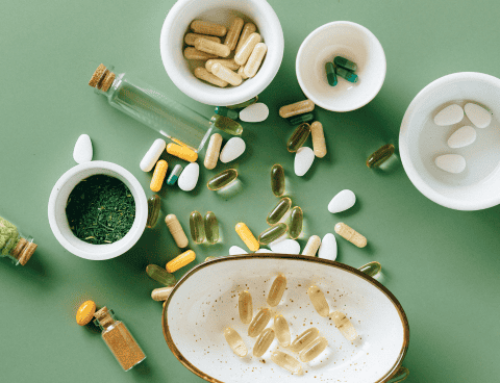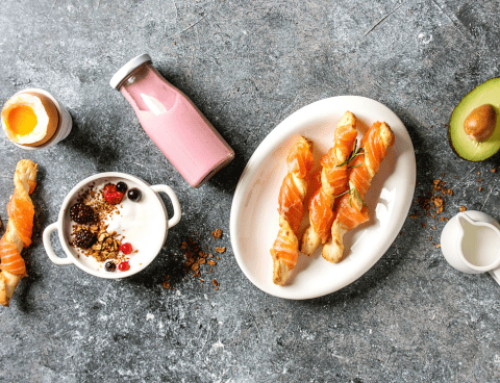Are Acai Bowls Actually Healthy?
Acai bowls are here to stay.
What started as a stylish trend years ago thanks in part to the rise of acai berries as a “superfood” has now become a staple. If you walk into the type of spot that slings smoothies or cold-pressed juices, you’re almost guaranteed to find some variation of an acai bowl on the menu. And why not? They’re photogenic, delicious and healthy. Well, at least they seem healthy. The dish’s exotic origins and the fact that most of its biggest fans are constantly clad in Lululemon apparel have helped create its nutritious image. But are acai bowls actually healthy? Here’s your answer.
What Are Acai Berries?
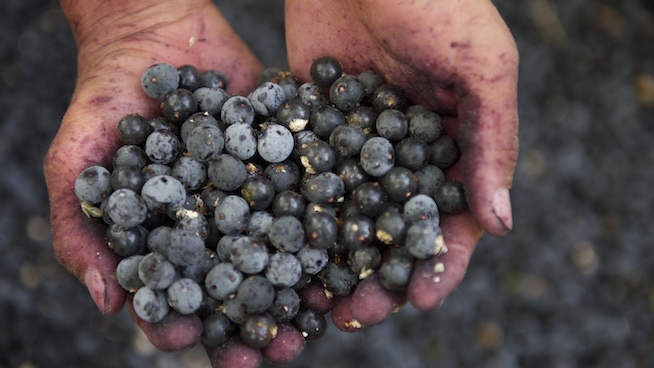
Acai berries are a small fruit harvested from acai palm trees, which are mostly native to northern South America. Acai berries themselves resemble grapes and are actually quite low in sugar, containing close to 0 grams per 100-gram serving.
According to the Mayo Clinic, acai berries are higher in antioxidants than other popular berries such as cranberries, blueberries and strawberries. They’re also high in fiber, calcium and vitamin A. Acai berries have been widely marketed as a “superfood” due to their extremely high antioxidant and phytochemical content. However, the National Institutes of Health states that “very little research has been done in people on the health effects of acai products.”
RELATED: 3 Fruits and Vegetables Athletes Must Eat
What Are Acai Bowls?
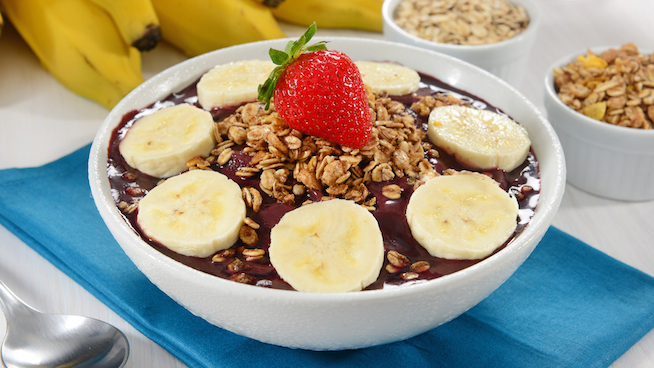
What makes an acai bowl is its base—a creamy purplish substance with a consistency not unlike frozen yogurt.
Since acai berries are grown so far away, fresh ones are rarely available in America. Instead, freeze-dried powders or purees are often used to create the base. These are mixed with a combination of ingredients such as almond milk, soy milk, nut butter, frozen fruit and fruit juice to achieve the desired consistency and taste.
This base is put in a bowl and topped with a few ingredients, such as granola, honey, nut butter, cacao nibs or fresh fruit. All of these ingredients are pretty healthy on their own, but bringing many of them together in the same dish raises a substantial issue—sugar.
Are Acai Bowls Actually Healthy?
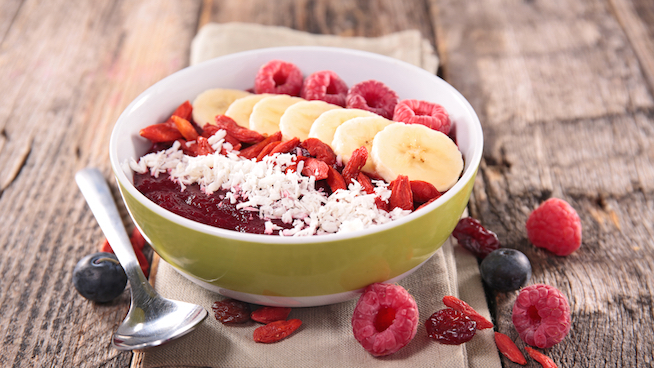
smoothie bowl
There’s a lot of good going on in the average acai bowl. Frozen fruit, fresh fruit, nut butter, almond milk, nuts, seeds—all are high-nutrient foods. The average acai bowl is filled with antioxidants, vitamins, minerals, fiber, protein and healthy fats.
RELATED: Eat The Peel Of These 12 Fruits and Vegetables
However, many of the ingredients in an acai bowl share the same issue—they’re high in sugar. This wouldn’t be a big deal if you were using just one of the ingredients in a dish. For example, spreading peanut butter on a piece of wheat toast won’t make the snack dangerously high in sugar. But when you combine fruit juice, frozen fruit, fresh fruit, nut butter, honey and granola in the same dish, the sugar total spirals out of control.
“You should really look at acai bowls as more of an occasional treat, not something you’d have as a meal,” Ilana Muhlstein, a Registered Dietitian Nutritionist at UCLA, told SHAPE. “Acai bowls can have 50 grams of sugar [the equivalent of 12 teaspoons], or double what the American Heart Association recommends for women for an entire day.”
For example, let’s look at the Acai Especial Bowl from Robeks. The ingredients in the base are acai puree, blueberries and bananas. It’s topped with sliced bananas and granola. It’s relatively high in vitamin C and fiber, but it contains a whopping 65 grams of sugar. That’s equivalent to a 20-ounce bottle of Coca-Cola. Other products contain even more sugar. Jamba Juice’s Acai Primo Bowl contains 67 grams of sugar and Juice It Up’s Ultimate Acai Bowl has 74 grams!
When you consider that many people eat acai bowls for breakfast or a snack, the sugar content becomes even more concerning. Many people might think eating an acai bowl is a “healthy choice” that gives them license to indulge in junk food later in the day, exacerbating the problem.
Consuming too much sugar has been linked to obesity, cardiovascular disease, diabetes and other negative health outcomes. While acai bowls have a lot of good things inside them, their typical sky-high sugar total cannot be overlooked. Other dishes offer similar nutrients without the startling amount of sugar. Steel-cut oats topped with fresh fruit and honey is one example.
Can you enjoy an acai bowl every once in a while? For sure. But you shouldn’t be eating them for breakfast or lunch several times per week. A smarter approach might involve replacing desserts like ice cream or frozen yogurt with an occasional acai bowl. You also have the option of making your own acai bowl, allowing you to better control the ingredients and sugar totals.
RECOMMENDED FOR YOU
MOST POPULAR
Are Acai Bowls Actually Healthy?
Acai bowls are here to stay.
What started as a stylish trend years ago thanks in part to the rise of acai berries as a “superfood” has now become a staple. If you walk into the type of spot that slings smoothies or cold-pressed juices, you’re almost guaranteed to find some variation of an acai bowl on the menu. And why not? They’re photogenic, delicious and healthy. Well, at least they seem healthy. The dish’s exotic origins and the fact that most of its biggest fans are constantly clad in Lululemon apparel have helped create its nutritious image. But are acai bowls actually healthy? Here’s your answer.
What Are Acai Berries?

Acai berries are a small fruit harvested from acai palm trees, which are mostly native to northern South America. Acai berries themselves resemble grapes and are actually quite low in sugar, containing close to 0 grams per 100-gram serving.
According to the Mayo Clinic, acai berries are higher in antioxidants than other popular berries such as cranberries, blueberries and strawberries. They’re also high in fiber, calcium and vitamin A. Acai berries have been widely marketed as a “superfood” due to their extremely high antioxidant and phytochemical content. However, the National Institutes of Health states that “very little research has been done in people on the health effects of acai products.”
RELATED: 3 Fruits and Vegetables Athletes Must Eat
What Are Acai Bowls?

What makes an acai bowl is its base—a creamy purplish substance with a consistency not unlike frozen yogurt.
Since acai berries are grown so far away, fresh ones are rarely available in America. Instead, freeze-dried powders or purees are often used to create the base. These are mixed with a combination of ingredients such as almond milk, soy milk, nut butter, frozen fruit and fruit juice to achieve the desired consistency and taste.
This base is put in a bowl and topped with a few ingredients, such as granola, honey, nut butter, cacao nibs or fresh fruit. All of these ingredients are pretty healthy on their own, but bringing many of them together in the same dish raises a substantial issue—sugar.
Are Acai Bowls Actually Healthy?

smoothie bowl
There’s a lot of good going on in the average acai bowl. Frozen fruit, fresh fruit, nut butter, almond milk, nuts, seeds—all are high-nutrient foods. The average acai bowl is filled with antioxidants, vitamins, minerals, fiber, protein and healthy fats.
RELATED: Eat The Peel Of These 12 Fruits and Vegetables
However, many of the ingredients in an acai bowl share the same issue—they’re high in sugar. This wouldn’t be a big deal if you were using just one of the ingredients in a dish. For example, spreading peanut butter on a piece of wheat toast won’t make the snack dangerously high in sugar. But when you combine fruit juice, frozen fruit, fresh fruit, nut butter, honey and granola in the same dish, the sugar total spirals out of control.
“You should really look at acai bowls as more of an occasional treat, not something you’d have as a meal,” Ilana Muhlstein, a Registered Dietitian Nutritionist at UCLA, told SHAPE. “Acai bowls can have 50 grams of sugar [the equivalent of 12 teaspoons], or double what the American Heart Association recommends for women for an entire day.”
For example, let’s look at the Acai Especial Bowl from Robeks. The ingredients in the base are acai puree, blueberries and bananas. It’s topped with sliced bananas and granola. It’s relatively high in vitamin C and fiber, but it contains a whopping 65 grams of sugar. That’s equivalent to a 20-ounce bottle of Coca-Cola. Other products contain even more sugar. Jamba Juice’s Acai Primo Bowl contains 67 grams of sugar and Juice It Up’s Ultimate Acai Bowl has 74 grams!
When you consider that many people eat acai bowls for breakfast or a snack, the sugar content becomes even more concerning. Many people might think eating an acai bowl is a “healthy choice” that gives them license to indulge in junk food later in the day, exacerbating the problem.
Consuming too much sugar has been linked to obesity, cardiovascular disease, diabetes and other negative health outcomes. While acai bowls have a lot of good things inside them, their typical sky-high sugar total cannot be overlooked. Other dishes offer similar nutrients without the startling amount of sugar. Steel-cut oats topped with fresh fruit and honey is one example.
Can you enjoy an acai bowl every once in a while? For sure. But you shouldn’t be eating them for breakfast or lunch several times per week. A smarter approach might involve replacing desserts like ice cream or frozen yogurt with an occasional acai bowl. You also have the option of making your own acai bowl, allowing you to better control the ingredients and sugar totals.


